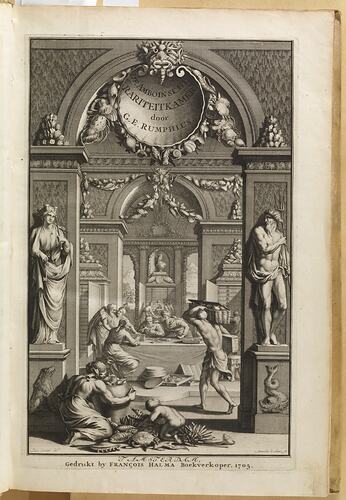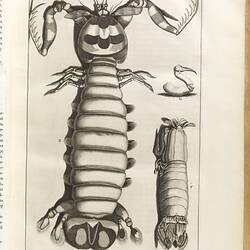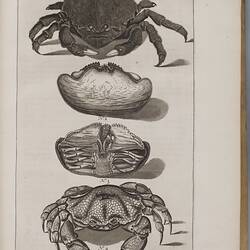Summary
This volume, 'D'Amboinsche rariteitkamer', known as the 'Ambonese curiosity cabinet' in English, looks at marine life, mineralogy, geology, and zoological fossils from the island of Amboina (Ambon) in what is now Eastern Indonesia.
Author, Georg Eberhard Rumphius, was a German-born botanist and a merchant for the Dutch East India Company. Rumphius experienced many hardships during the writing of his works. In 1670, Rumphius went blind due to glaucoma, continuing to work on his manuscript with the help of others. In 1674, his wife and daughter were killed by a wall that collapsed during an earthquake. In 1687, with his project nearing completion, a fire destroyed his library, manuscripts, and original illustrations, and in 1690 a ship carrying his manuscript to the Netherlands was attacked and sunk by the French. Despite these hardships, he produced two influential accounts of the natural history of the region, both of which were published after his death in 1702. The companion to this volume is a work focusing on botany.
The illustrations are engravings, possibly made after the drawings of the German entomologist Maria Sibylla Merian. Sixty engraved plates show over 600 figures of crustaceans, urchins, starfish, shellfish and minerals, which are accompanied by descriptions. This edition includes a frontispiece and portrait of Rumphius by Jacob de Later, based on a work by Paul Augustus Rumphius. Published in Amsterdam in 1705 by François Halma, this is a first edition of the work.
Written in Dutch, this edition has several indexes in different languages including Latin, German, Belgium, English and French.
This edition is rare in Australian public collections, with one copy held by Museums Victoria and another held by the Western Australian Museum.
Physical Description
Bound volume comprising 340 pages numbered using both Roman and Arabic numerals. Letterpress with 60 engraved plates, four engraved vignettes an engraved author portrait and frontispiece. Embossed vellum binding.
Significance
In 'D'Amboinsche rariteitkamer', Rumphius provided the first known drawing of the nautilus animal, presented outside of the shell in between drawings of two empty shells, one whole and one cross-sectioned.
This is a pre-Linnaean work, arranged according to a classicification system devised by Rumphius. It is considered a classic 18th century work of natural history.
More Information
-
Collecting Areas
-
Author
Georg E. Rumpf, Indonesia, 1705
Rumphius worked on this volume for many years after arriving in the region in 1653, completing the work before he died in 1702. The work was not published until 1705. -
Artist
Maria S. Merian, Amsterdam, Netherlands
It is possible that some of the engravings were made after original artwork by Maria Sibylla Merian. -
Publisher
Printed and published by François Halma, Amsterdam, Netherlands, 1705. Source of date: Publication date (date made). -
Inscriptions
Includes armorial bookplate of of the Princes of Liechtenstein 'Ex-libris Liechtensteinianis'.
-
Category
-
Discipline
-
Type of item
-
Exhibition Collection Management
550 mm (Width), 410 mm (Depth), 140 mm (Height)
Estimated display dimensions - open book (Scientific Illustration)
-
Maximum dimensions
274 mm (Width), 51 mm (Depth), 406 mm (Height)
Measurement From Conservation. Book when closed
-
References
Rumpf, G. E. (1999) The ambonese curiosity cabinet. Translated by E. M. Beekman. New Haven and London: Yale University Press. Kean, J. (2013) The art of science : remarkable natural history illustrations from museum victoria. Melbourne, Victoria, Australia: Museum Victoria. Smithsonian Institution (no date) George Everhard Rumphius, Smithsonian Institution. Available at: [Link 1] (Accessed: 09 June 2023). The Mineralogical Record (2020) Rumpf (rumphius) Georg Eberhard, Mineralogical Record. Available at: [Link 2] (Accessed: 09 June 2023). Online version via the Biodiversity Heritage Library [Link 3]
-
Keywords
Natural History, Marine animals, Mineralogy, Mollusks, Crustacea, Indonesia, Geology, Botany, Early works to 1800






